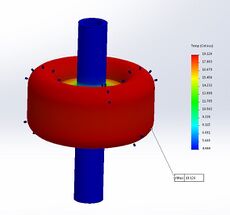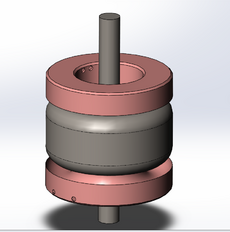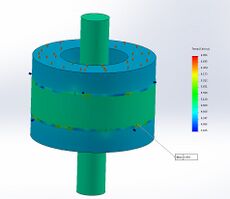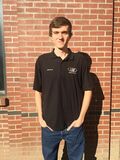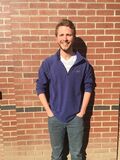Lunar Flywheel Energy Storage System
The goal of this project is to develop mathematical and physical models, that with inputs and parameters will calculate needed dimensions and values for both the electrical and mechanical aspects of a stator for a high-speed flywheel. This is a carry over from a previously designed and built low-speed flywheel system.
| FES System in Vacuum Chamber | |
| Team Name | Lunar Flywheel |
| Sponsors | Herb Hess Christine Berven |
| Mentor | Feng Li |
| Duration | Fall 2016 - Spring 2017 |
Background
One of the problems a potential lunar mission faces is energy generation and storage. While both solar and nuclear power generation are options, they do have drawbacks. Generating electricity using solar power would not be possible during the approximately 14-day lunar night, and nuclear power generation would have to decrease during the lunar day due to heat. As a result of these drawbacks, an efficient method of storing energy would be needed to ensure the success of any planned lunar mission. The University of Idaho's Dr. Joe Law has put forward the idea of using a flywheel energy storage system (FESS) to accomplish this and has since been researched by students within the university. FESS is advantageous due to its high energy density and low maintenance compared to other methods of energy storage.
The previous years, a low-speed FESS was manufactured, but now the research team at UIdaho (multi-discipline, cross college group consisting of graduate and undergraduate students from the Physics, Electrical and Computer Engineering, Mechanical Engineering, and Computer Science Departments) has started to focus on developing a high-speed FESS. The goal is to store a magnitude times more energy than the low-speed version. Whether this is still feasible or not, is still being determined due to a plethora of aspects, such as material property constraints within the flywheel, how quickly it can be accelerated, and numerous other factors. The purpose behind this senior design project is to develop mathematical and physical models that will calculate various stator parameters for both the electrical and mechanical aspects.
Stator
Determining the UIFESS stator parameters and dimensions is the task for this senior design project. There are two main disciplines to the stator design; electrical and mechanical.
Electrical Aspect of Stator Design
The electrical engineers of the team have been tasked with determining the general electrical machinery necessary for the development of a field regulated reluctance machine (FRRM).
Torque Modeling
Torque produced by the FRRM is directly proportional to the input current. Developing a torque model entails the fatigue issues creating within the reversal of the machine accelerating and decelerating.
Efficiency Modeling
Efficiency is a measurement of how well a machine is operating. The development of an efficiency model will produce the power losses in the system. These power losses are dispensed into the system as heat dissipation, which if not controlled will result in a feedback of more losses and lower efficiency within the system. The efficiency is also directly proportional to the speed of the machine, which is needed to be in the range of tens of thousands of RPM (rather than the thousands of RPM currently capable in the low-speed FESS).
Mechanical Aspect of Stator Design
The mechanical engineers on the Lunar Flywheel team were tasked with solving the fatigue and heat transfer issues seen by the stator when under operation.
Fatigue Cyclical Loading Modeling
While the FESS is operational, it will be accelerated and decelerated over a set period of time by a specified torque. This torque will be full fully reversed when either accelerating or decelerating the flywheel, causing fatigue, torsional load on the stator. The team is analyzing this problem using stress analysis and the modified Goodman equations.
Heat Transfer Model
Also, while the FESS is operational, thermal heat will be produced by the stator coil windings. The coil wires for the windings, have a small resistance and once a current is passed through them to create the torque required to rotate the FESS, heat will be produced. Removing this heat is imperative to keeping the efficiency of the FRRM as high as possible, and reducing the temperature of the coils increases their life expectancy. The images below show some of our preliminary ideas for removing the heat from the stator laminations
Design Process
Problem Statement
From previous Capstone design teams, a low-speed FESS was designed and built. The research group has moved forward with the intent to produce a high-speed FESS. While parameters for the high-speed rotor are being determined, the senior design team is tasked with producing models, the stator dimensions can be calculated quickly using inputs from the rotor dimensions.
Specifications
High Priority:
Target Velocity: 25,000 - 30,000 RPM
Time to Reach Target: 1 day
Minimum Allowable Air Gap: 1 mm
Math models can easily be adjusted
Medium Priority:
Energy Efficiency: 70% During Acceleration
Maximum Coil Temperature: 100 C
Maximum Velocity Overshoot: 10 rad/s
Maximum Settling Time: 1 s
Maximum Rise Time: 10 s
Design Development
As stated, the Lunar Flywheel team was responsible for developing math models that would calculate the parameters for the electrical and mechanical aspects of the stator.
Material Testing Prior to the mathematical and physical model development, the team has been researching and testing materials that can be used for the high speed rotor.
Toroid Permeability Test: The electrical team did required tests of toroids made out of different combinations of iron and carbon fiber to understand the permeability properties and options for the stator.
File:FlywheelToroidPermiabilityExperimentAnalysis.pdf
Team Bios
The 'Lunar Flywheel' team contributed to this project from Fall 2016 - Spring 2017 and was responsible developing models to calculate the desired stator parameters. The team consisted of the following members:
| Team 'Lunar Flywheel' | |||||
|---|---|---|---|---|---|
| Picture | Biography | Discipline | |||
| Cooper Atkinson | Cooper Atkinson is from Tri Cities in southeastern Washington. Cooper enjoys structural analysis and solid modeling. Outside of school, he is a photographer and avid outdoorsman. | Mechanical Engineering | |||
| Nicholas Bachus | Nicholas Bachus is from Grass Valley in northern California. Nicholas engineering focus is towards dynamic modeling, finite element analysis, and modeling of composite materials. Outside of school, he enjoys playing basketball and traveling. | Mechanical Engineering | |||
| Shea Morrison | Shea Morrison is a Senior from Boise, ID. Outside of classwork, Shea is extremely involved on campus, being an active member and holding offices in IEEE, ECE Ambassadors, and Tri Delta. Her favorite pastime is hanging out with her dogs and hiking. | Electrical Engineering | |||
| Kyle Peterson | Kyle Peterson is from Orofino in northern Idaho. Kyle has experience with microbiology research, Jupiter robotic mobility concepts, utilities infrastructure, and high altitude ballooning. | Mechanical Engineering | |||
| Matt Phillips | Matt Phillips was born and raised in Boise, Idaho ad enjoys hiking, video games, and cooking. He is emphasizing in power and is currently the TA for Energy Systems I. | Electrical Engineering | |||
Additional Documentation
Meeting Minutes
File:Flywheel Minutes.pdf
File:Flywheel Expo Poster.pdf
File:Flywheel Expo Presentation.pdf
